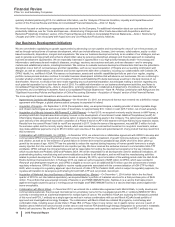Pfizer 2015 Annual Report Download - page 21
Download and view the complete annual report
Please find page 21 of the 2015 Pfizer annual report below. You can navigate through the pages in the report by either clicking on the pages listed below, or by using the keyword search tool below to find specific information within the annual report.
Financial Review
Pfizer Inc. and Subsidiary Companies
20
2015 Financial Report
• the loss of exclusivity and subsequent multi-source generic competition for Detrol LA, Celebrex and Geodon in the U.S., Viagra in most
major European markets, and Aricept and Lyrica in Canada (aggregate decline of approximately $937 million) and certain other products
(approximately $300 million);
• the continued erosion of branded Lipitor in the U.S. and most other developed markets due to generic competition and the operational
decline of certain products, including Norvasc, Effexor, atorvastatin, Metaxalone, Zosyn/Tazocin, Ziprasidone, Genotropin, Tygacil,
Centrum, Advil and Vfend (approximately $938 million); and
• the ongoing termination of the Spiriva collaboration in certain countries (approximately $490 million),
partially offset by:
• the operational growth of certain products in certain developed markets, including Lyrica, Prevnar, Eliquis, Xeljanz, Xalkori, Inlyta and
Nexium 24HR in the U.S. as a result of its May 2014 launch, among others (approximately $1.8 billion); and
• a 7% operational increase in revenues in emerging markets (approximately $900 million), including strong operational growth from
Prevenar as well as from Lipitor, primarily in China, and from Enbrel, primarily in Latin America.
See the “Intellectual Property Rights and Collaboration/Licensing Rights” section of this Financial Report for information about (i) recent losses
of product exclusivity impacting product revenues, (ii) recent and expected losses of collaboration rights impacting alliance revenues and (iii)
losses and expected losses of product exclusivity in 2016.
In addition, we expect to lose exclusivity for various other products in various markets over the next few years. For additional information, see
the “Patents and Other Intellectual Property Rights” section in Part I, Item 1, “Business”, of our 2015 Annual Report on Form 10-K.
We have significant operations outside the U.S., with revenues exceeding $500 million in the following number of countries:
The U.S. and Japan are our two largest national markets:
Revenues by Market
Our policy relating to the supply of pharmaceutical inventory at domestic wholesalers, and in major international markets, is to generally
maintain stocking levels under one month on average and to keep monthly levels consistent from year to year based on patterns of utilization.
We historically have been able to closely monitor these customer stocking levels by purchasing information from our customers directly or by
obtaining other third-party information. We believe our data sources to be directionally reliable but cannot verify their accuracy. Further, as we
do not control this third-party data, we cannot be assured of continuing access. Unusual buying patterns and utilization are promptly
investigated.
Revenue Deductions
Our gross product revenues are subject to a variety of deductions that are generally estimated and recorded in the same period that the
revenues are recognized, and primarily represent rebates, chargebacks and sales allowances to government agencies, wholesalers/
distributors and managed care organizations with respect to our pharmaceutical products. Those deductions represent estimates of rebates
and discounts related to gross sales for the reporting period and, as such, knowledge and judgment of market conditions and practice are
required when estimating the impact of these revenue deductions on gross sales for a reporting period.
Historically, our adjustments of estimates, to reflect actual results or updated expectations, have not been material to our overall business. On
a quarterly basis, our adjustments of estimates to reflect actual results generally have been less than 1% of revenues, and have resulted in
either a net increase or a net decrease in revenues. Product-specific rebates, however, can have a significant impact on year-over-year
2015 2014 2013
Number of Non-U.S. Countries with
$500MM+ Revenues
12 12 12
2015
U.S.
44%
Other
48%
Japan
8%
2014
U.S.
38% Other
53%
Japan
9%
2013
U.S.
39% Other
51%
Japan
10%
























